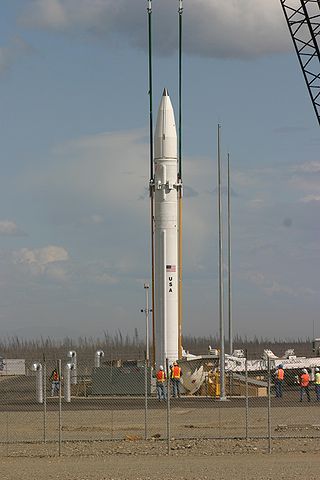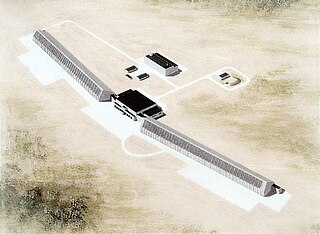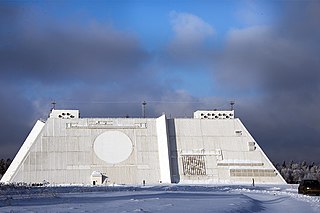
An anti-ballistic missile (ABM) is a surface-to-air missile designed to counter ballistic missiles. Ballistic missiles are used to deliver nuclear, chemical, biological, or conventional warheads in a ballistic flight trajectory. The term "anti-ballistic missile" is a generic term for a system designed to intercept and destroy any type of ballistic threat; however, it is commonly used for systems specifically designed to counter intercontinental ballistic missiles (ICBMs).

Missile defense is a system, weapon, or technology involved in the detection, tracking, interception, and also the destruction of attacking missiles. Conceived as a defense against nuclear-armed intercontinental ballistic missiles (ICBMs), its application has broadened to include shorter-ranged non-nuclear tactical and theater missiles.

Sary Shagan is an anti-ballistic missile testing range located in Kazakhstan.

The A-35 anti-ballistic missile system was a Soviet military anti-ballistic missile (ABM) system deployed around Moscow to intercept enemy ballistic missiles targeting the city or its surrounding areas. The A-35 was the only Soviet ABM system allowed under the 1972 Anti-Ballistic Missile Treaty. In development as of the 1960s and in operation from June 1972 until the 1990s, it featured the nuclear-armed A350 exoatmospheric interceptor missile. The A-35 was supported by two Dunay radars and the Soviet early warning system. It was followed by the A-135 in the early 1990s.

Dunay radar was a system of two Soviet radars used to detect American ballistic missiles fired at Moscow. They were part of the A-35 anti-ballistic missile system. One sector of one of the radars, the Dunay-3U is still operational and is run by the Russian Space Forces as part of the Main Control Centre of Outer Space.

Gabala Radar Station was a Daryal-type bistatic Passive electronically scanned array early warning radar, built by the Soviet Union in the Qabala district of the Azerbaijan SSR in 1985. It was operated by the Russian Aerospace Defence Forces and closed at the end of 2012. The radar station had a range of up to 6,000 kilometres (3,728 mi), and was designed to detect missile launches as far as the Indian Ocean. The radar's surveillance covered Iran, Turkey, India, Iraq and the entire Middle East. It could detect the launch of missiles and track the whole trajectory to enable a ballistic missile defense system to intercept an offensive strike. The Radar Station hosted about 1,000 Russian servicemen with about 500 Azerbaijanis.

Baranavichy Radar Station is a 70M6 Volga-type radar near Hantsavichy. It is an early warning radar, which is run by the Russian Space Forces. It is designed to identify launches of ballistic missiles from western Europe and can also track some artificial satellites, partly replacing the demolished radar station at Skrunda in Latvia.

The A-350 GRAU 5V61 was a Soviet, nuclear armed surface-to-air anti-ballistic missile. The A-350 was a component of the A-35 anti-ballistic missile system. Its primary mission was to destroy U.S. Minuteman and Titan intercontinental ballistic missiles targeting Moscow.

The 53T6 is a USSR anti-ballistic missile. Designed in 1978 and in service since 1995, it is a component of the A-135 anti-ballistic missile system.

The Daryal-type radar is a Soviet bistatic early-warning radar. It consists of two separate large active phased-array antennas separated by around 500 metres (1,640 ft) to 1.5 kilometres (4,921 ft). The transmitter array is 30 m × 40 m and the receiver is 80 m × 80 m in size. The system is a VHF system operating at a wavelength of 1.5 to 2 meters. Its initial transmit capacity was 50 MW with a target capacity of 350 MW.

The Russian Aerospace Defence Forces or Russian Air and Space Defence Forces (VVKO) was a branch of the Armed Forces of the Russian Federation responsible for aerospace defence, and the operation of Russian military satellites and the Plesetsk Cosmodrome. It was established on 1 December 2011 and replaced the Russian Space Forces.

Dnestr radar and Dnepr radar, both known by the NATO reporting name Hen House are the first generation of Soviet space surveillance and early warning radars. Six radars of this type were built around the periphery of the Soviet Union starting in the 1960s to provide ballistic missile warnings for attacks from different directions. They were the primary Soviet early warning radars for much of the later Cold War. In common with other Soviet and Russian early warning radars they are named after rivers, the Dnestr and the Dnepr.

The Don-2N radar is a large missile defense and early warning active electronically scanned array radar outside Moscow, and a key part of the Russian A-135 anti-ballistic missile system designed for the defense of the capital against ballistic missiles. Located near Sofrino in Pushkinsky District of Moscow Oblast, it is a quadrangular frustum 33 m (108 ft) tall with sides 130 m (427 ft) long at the bottom, and 90 m (295 ft) long at the top. Each of its four faces has an 18 m (59 ft) diameter Super high frequency band radar giving 360 degree coverage. To the right of each circular search and track array, separated by a vertical structure for shielding, is a square antenna array for guiding the interceptor missile by data link. The system is run by an Elbrus-2 supercomputer.
Oko is a Russian missile defence early warning programme consisting of satellites in Molniya and geosynchronous orbits. Oko satellites are used to identify launches of ballistic missiles by detection of their engines' exhaust plume in infrared light, and complement other early warning facilities such as Voronezh, Daryal and Dnepr radars. The information provided by these sensors can be used for the A-135 anti-ballistic missile system which defends Moscow. The satellites are run by the Russian Aerospace Forces, and previously the Russian Aerospace Defence Forces and Russian Space Forces. Since November 2015, it is being replaced by the new EKS system.
Serpukhov-15 is a military townlet near Kurilovo in Kaluga Oblast which is the location of the western control centre for Russia's Oko satellites. These give early warning of ballistic missile launches, mainly from the continental United States. The site is part of the Main Centre for Missile Attack Warning and information from here is processed at the Russian Aerospace Defence Forces centre in Solnechnogorsk and could be used, together with early warning radar such as the Voronezh, for launch on warning of the A-135 anti-ballistic missile system. A similar facility is located at Pivan-1 in the Russian Far East.
Pivan-1 is a military townlet near Komsomolsk-na-Amur in Khabarovsk Krai in the Russian Far East which is the location of the eastern control centre for Russia's Oko satellites. These give early warning of ballistic missile launches, mainly from the continental United States. The site is part of the Main Centre for Missile Attack Warning and information from here is processed at the Russian Aerospace Defence Forces centre in Solnechnogorsk and could be used, together with early warning radar such as the Voronezh, for launch on warning or the A-135 anti-ballistic missile system. A similar facility is located at Serpukhov-15 near Moscow.
The 820th Main Centre for Missile Attack Warning is the Russian Space Forces early warning network against ballistic missile attack. It has headquarters in the village of Timonovo near Solnechnogorsk outside Moscow and is part of the Russian Space Forces of the Aerospace Forces. The centre consists of a network of early warning radar stations which transmit their data to the control centre near Solnechnogorsk. Other information comes from the early warning Oko and EKS satellites as well as the Don-2N missile defence radar. Information from the centre could be used for a launch on warning nuclear missile attack or to engage the A-135 anti-ballistic missile system.

Missile defense systems are a type of missile defense intended to shield a country against incoming missiles, such as intercontinental ballistic missiles (ICBMs) or other ballistic missiles. The United States, Russia, India, France, Israel, Italy, United Kingdom, China and Iran have all developed missile defense systems.

The 5N65 radar was a Soviet military phased array radar initially designed for the S-225 anti-ballistic missile system which was never commissioned. The radar was later installed near the Kura Test Range in Kamchatka in the Russian Far East as a part of 5K17 tracking and measuring system and was demolished in 2006.
System A-235 PL-19 Nudol is a Russian hypersonic anti-ballistic missile and anti-satellite weapon system in development. It is designed to deflect a nuclear attack on Moscow and other regions within European Russia. The main developer of the system is JSC Concern VKO Almaz-Antey. The new system should replace the current one — A-135. The two main differences will be that the A-235 will use conventional warheads and it will be road-mobile.



















